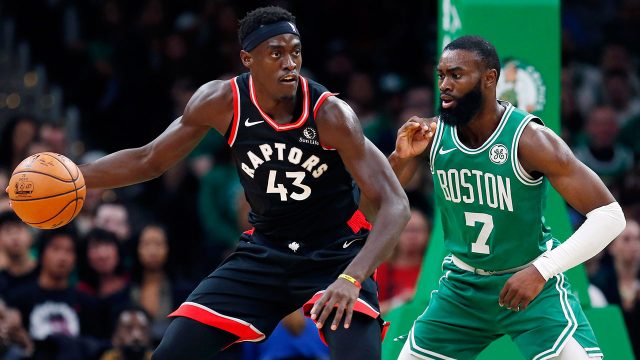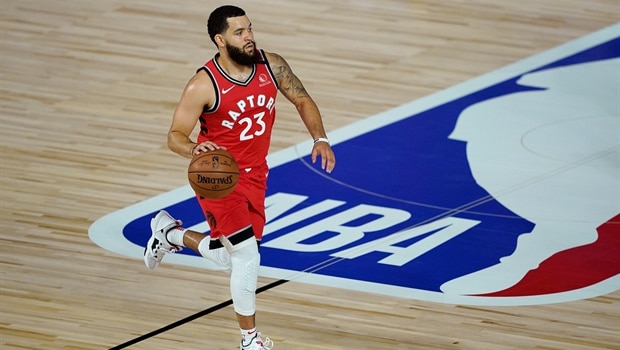If there is reason to worry about Pascal Siakam, it is only because of the lofty expectations he has set.
From G League to Bench Mob to Most Improved to All-Star starter, Siakam’s exponential gains each off-season have caused many to reassess the lens through which we view players new to the game and development as a whole. But what happens when the new model for development hits a lull?
Siakam, while exhibiting some solid decision making thus far, has been inefficient in a key aspect of his game. Through four games in the Orlando bubble, he has shot 6-for-16 at the rim (37.5%) — currently lower than what he’s shooting from either the mid-range or 3-point line. Prior to the hiatus due to COVID-19, Siakam was at 62.3%. It’s important to bear in mind that four games is a minute sample size relative to 53 games prior, and there’s no reason to assume Siakam won’t return to some semblance of normalcy soon enough.
It does bear asking the question of how much other teams have benefited from scouting the Raptors over the past four months compared to what Siakam actually gained with the time off. The 26-year-old acknowledged that this was the longest he went without playing basketball since his late start, and the realities of being stuck in his Toronto condo without access to a court may be rearing its ugly head, at least early.
This was always going to be a season of learning for Siakam. He has been challenged to fill the shoes of a superstar No. 1 option on offence and Rome was not built in a day. Nights like the one against Boston and this stretch of seeding games as a whole are what will make him better in seasons to come. The key to Siakam’s growth has been his ability to embrace failure and sink his teeth into his weaknesses, confront them head on, and work at improving them.
Let’s dive into what aspects of this shellacking by Boston can help him become better in the future.
OPERATING FROM THE PERIMETER
The biggest things Siakam will take from this game is understanding exactly how the Celtics will look to come at him. Essentially, they are comfortable with switching everyone but Kemba Walker onto him. Jaylen Brown was the primary defender on this night and I wouldn’t expect that to change. Jayson Tatum picked him up on switches, as did Daniel Theis, but the one thing the Celtics absolutely would not concede was Walker on him.
Siakam averages a pedestrian 0.84 points per possession as a pick-and-roll ball handler and 0.86 points per isolation. Boston’s ability to switch on the perimeter and their overall mobility and size with their wing depth negates some of Toronto’s ball movement. There were aspects of the Raptors’ offence we did not see, and so that must be kept in mind when evaluating this game.
POST-UPS
On the season, Siakam averages just under three post-up possessions per game and has produced 0.92 points per. That value is similar to Giannis Antetokounmpo, Anthony Davis and Damontas Sabonis, but well below league leader Joel Embiid at 1.11 (on 8.5 possessions) and the likes of DeMar DeRozan (1.03) and Kawhi Leonard (1.00).
The Raptors weren’t using their best sets in this game as there’s no sense in giving the Celtics film to work with ahead of the playoffs, and so there were more post-ups than usual for Siakam on this night. This, frankly, may also be preparation for the playoffs where certain sets get taken away and so Siakam’s ability to create a shot for either himself or others out of the post may become more of a necessity.
In the first play below, Siakam usually makes the read to post up his defender toward the help but quickly spin to the weakside for an uncontested shot. He settles for the fadeaway here, and in a game that matters more, you’d like to see him set the tone early with some aggression going towards the basket. Soon after, Nick Nurse comes out of the timeout looking to get Siakam going with an easy one and Siakam misses a very makeable hook shot above Brown after securing great position.
The third play (0:15) highlights Lowry’s effort to get Walker switched onto Siakam in the post, but the Celtics do a good job of scrapping that and Brown works his way to Siakam before the Cameroonian inflicts his own wound with a travel. Plays 4 and 5 show Siakam’s adjustment, going back to what we’ve grown accustomed to seeing him do, backing down his opponent, spinning to the weakside, and finishing with ease from there. With those two plays playing on Brown’s mind, Siakam is then able to use that to his advantage in Play 6 and come back to the strong side for a fairly uncontested finish.
INTENSITY NOT QUITE THERE
This is a criticism that can be made of most of the team, but we’re breaking down Siakam here, and as one of the premier players on the team, he does bear a significant chunk of the responsibility in coming out with the right mindset from the jump. As noted earlier with him settling for a mid-range fadeaway to start the game, the first possession in this clip shows him flat-footed which allows for the straight line drive from Theis for the basket, plus the poor touch-foul by Siakam. In the second play, it’s Brown he catches Siakam a bit off-guard and has him backpedaling in a hurry but to no avail.
The third and fourth plays above show Tatum’s ability to make quality reads. Siakam has played a fundamental role in the Raptors’ ability to protect the paint as a helper but Tatum’s recognition of where the help is coming from and traps directed towards him see him making quick swings that force Siakam into scramble mode.
Nurse did not get in his bag defensively in this one, quite possibly holding back, but the amount of ball handling and shot creation on the Celtics does make me curious to see how often and how effective his zone options can be against them. The playoffs are all about matchups, and the Celtics presenting a yin to several aspects of the Raptors’ yang is what makes this potential Eastern Conference semifinal matchup so enticing.
MADE TO WORK
One final thing I did want to highlight is how the Celtics made Siakam and the Raptors defence work through stagger screens and misdirection. Again, having multiple ball handlers and shot creators elevates the degree to which this can be a problem, and while Nurse will certainly have his squad battling these aspects in different ways if they meet again, it’s another aspect in which Toronto’s defence will be tested.
Like with other stars, making Siakam work on the defensive end will be a priority for opponents, and the Celtics’ ability to take care of the ball — sixth in turnover ratio, per Cleaning the Glass — also negates some of Toronto’s ability to get out in their beloved transition.
Walker is an elite pick-and-roll ball handler, tied for second in the league with Chris Paul and only behind Damian Lillard at 1.09 points per possession. His health is paramount to Boston’s offensive potency in the post-season. Tatum isn’t far behind at seventh with 1.04 points per while Marcus Smart — believe it or not — is a shade ahead of Lowry at 1.02 points per, albeit on a couple possessions fewer.
On the surface, from Toronto’s coaches to players, the consensus is that this game gets thrown in the trash and the team moves on to the next one. That’s certainly the right way to go as far as putting a contextually light loss behind them, but behind closed doors, they should be aware of the threat Boston presents.
Siakam finishes the season series having played two of the four games, averaging 22 points on 43.2 percent shooting, five rebounds, and one assist to 3.5 turnovers per game. If the Raptors do indeed face off against the Celtics in the second round, a big part of progressing past that will depend on how quickly Siakam can learn from the questions the Celtics and other strong defensive teams have posed.




